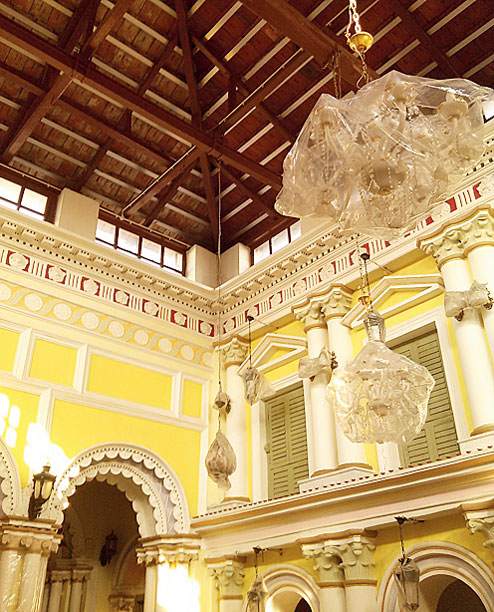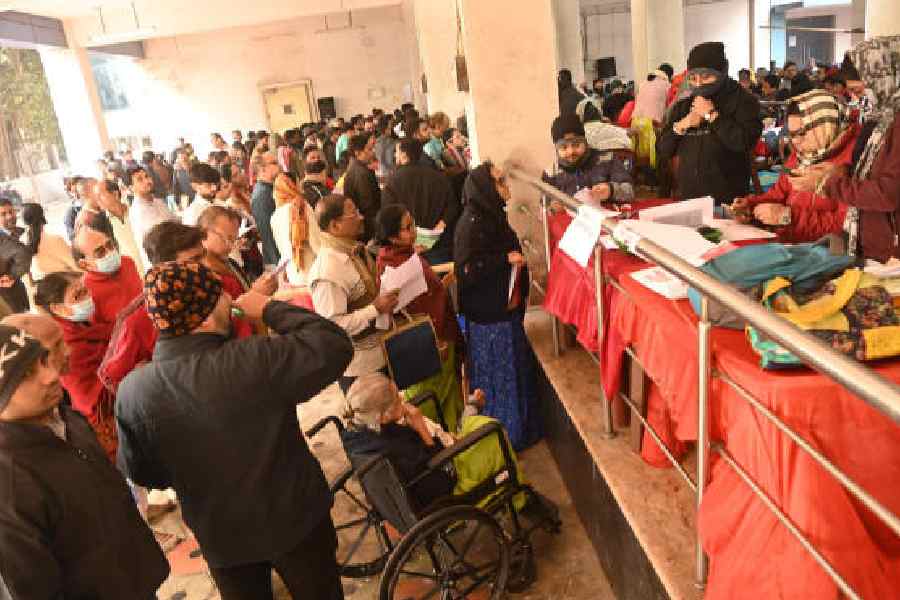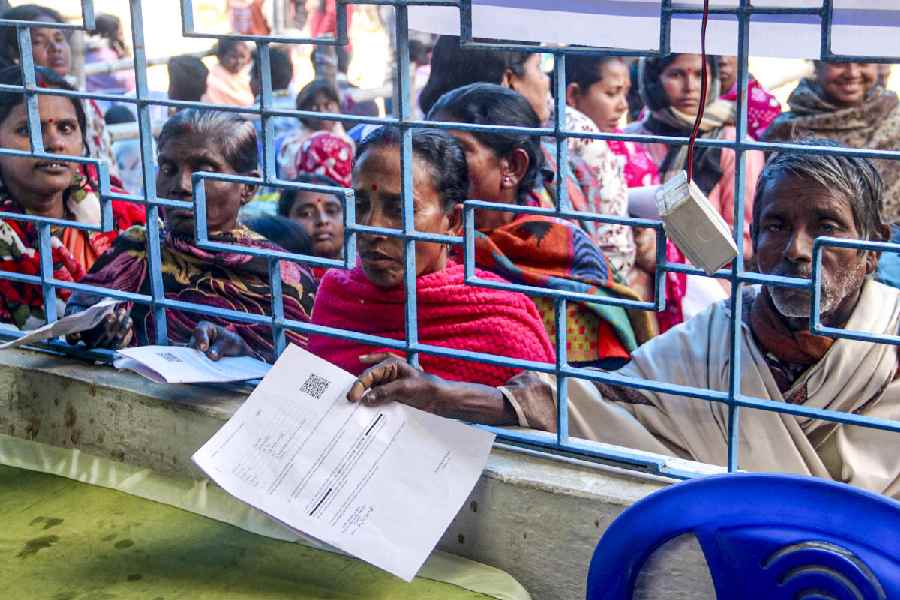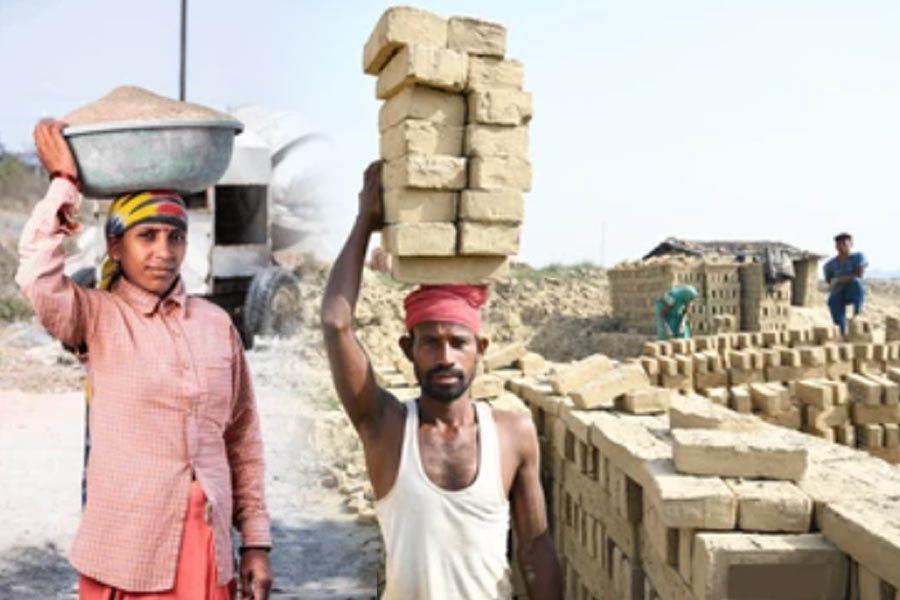 |
 |
 |
 |
 |
It is difficult to say whether one should be alarmed or excited about the fact that State and private bodies suddenly seem to have realized that Murshidabad, the capital of Gour Banga before it became Bengal, has a heritage waiting to be peddled. While a private organization, Murshidabad Heritage Development Society, recently held “Resurgence — Murshidabad Heritage Festival 2014”, aimed at “sensitising youth to value India’s rich heritage and attract tourists” (sic), Mamata Banerjee has seized Motijheel, a lake in Murshidabad town, to show her zeal for the past and the present. Motijheel had been created by Alivardi Khan’s son-in-law, Mohammed Nawazish Khan, and was dedicated to his wife, Ghaseti Begum, sometime in the mid-18th century. Nobody would be in doubt about who the queen is now as one enters the Motijheel complex — Didi beams from hoardings declaring her achievement in sprucing up the area. She surely has a feel for tourists’ preferences. Niribili Tourist Lodge, consisting of concrete huts painted bright yellow and ash, is coming up on the lakeshore. There are other huts with multi-coloured polka dots, and a granite plaque marking the inauguration of the 13-crore project by Banerjee in August this year. It is embossed in a wall with rounded swellings, a style of construction that seems to be much-favoured by state government architects. Standing here, one might feel that one is in that Rajarhat park, where Banerjee woos businessmen, rather than in a historical site.
The mosque within the complex has recently been taken over by the Archaeological Survey of India. It is getting a new wall as a result — the supervisor at the site says that the bricks have been specially made, keeping the proportions of the original blocks intact. Lime and the dust of crumbled bricks (chun-surki) are being used instead of cement. Making way through the thick red dust kicked up by the masons, one finds the disintegrating graves (picture, top right) of Motijheel’s creator, Mohammed Nawazish Khan, and of Ekram-ud-Daulah, the nawab’s adopted son who was also Siraj-ud-Daulah’s elder brother. The nawab died of grief when young Ekram succumbed to small pox. Ghaseti Begum, however, was made of sterner stuff. After failing to put the son of her second sister on the throne in the melee that followed the death of her father, Alivardi Khan, Ghaseti swore lifelong vengeance against Siraj. She possessed unimaginable riches, the lure of which made Siraj too fight her to the hilt. However, as conclusion to the boiling conspiracies in which Ghaseti got together with Mir Jafar, the Indian Judas, and the English to defeat Siraj, both Siraj and Ghaseti met with a violent end. She was thrown into the river by order of Mir Jafar’s son.
Murshidabad’s Muslim history is unusual not only in having royal lines that trace their beginnings to commoners but also in featuring exceptionally strong women. Besides Ghaseti, there is Munni Begum, the second wife of Mir Jafar. Like Ghaseti, who took over the reigns of administration after her husband’s demise, Munni Begum too became an important figure in the political and social life of Murshidabad after Mir Jafar’s death. The mosque constructed by her in 1767, called Chowk Masjid, still stands, and is now under the protection of the ASI, which has probably painted it whiter than ever before.
Her living legacy, in an indirect way, is the Nawab Bahadur’s Institution, the only fully state-owned school in Murshidabad, that was reportedly run for years on the liberal grant made by Munni. The beautifully austere building that houses the school was designed by Colonel McLeod, the British architect who had also planned the Hazarduari Palace — the structure now synonymous with Murshidabad. In the late 1990s, the school became the centre of controversy when the then principal tried to have a portion demolished in the name of renovation and a group of ex-students made a petition against the decision to the court, which stalled the attempt. The present headmaster, Habibur Rahaman, says that whatever renovation has taken place in this heritage property ever since has been done keeping in mind the original plan drawings. However, the fact that the Public Works Department, which is in charge of looking after the property, is falling short of its duty is evident from the spreading damp on the walls, streaks of lichen on the ceilings, and the dust that seems to have settled permanently everywhere.
The Krishnath College in Behrampore, constructed in 1853 to rival Oxford, has a similar story to tell. The clocks in the tower have stopped long ago. The present acting principal of the college, Kalyanaksha Ghosh, highlights the dilemmas of a property being labelled, or not being labelled, as heritage in this country. Apparently, the authorities who decide on heritage issues were initially reluctant to grant the college the status because its pictures on the net did not make it look ruined enough. But they seem to have made up their mind at last now, and after much paperwork, are sending men from a consultant firm to do the measurements for renovation. As more and more delays take place in the process, water seeps in a little deeper into the vaulted teak-wood ceilings (picture, bottom centre), the icicle-shaped stains under the Gothic windows grow longer, and water collects in larger pools in the chemistry laboratory each time it rains. The principal states categorically that it is not possible for the college administration to maintain this grand building without adequate funds from government agencies. It doesn’t help matters that the president of the college, the only MP from Murshidabad, belongs to a party that sits in opposition to the ruling party of the state.
Some superficial repair work had been done when the college celebrated its 150th anniversary in 2003. The comical-looking bust of Raja Krishnath Roy (1822-1844) was placed in its present position at the entrance then, to honour the zamindar whose generous funds had allowed the founding of the college. Raja Krishnath, who committed suicide at the age of 22, belonged to the Roy family of Cossimbazar who were famous patrons of art and education. Their ancestral seat in Cossimbazar (called the Sripur Palace or the Boro Rajbari), which had once played host to the first annual conference of the Bangiya Sahitya Sammelan, presided over by Rabindranath, is falling apart now. Visitors are not let in for reasons best known to the present owners. Somewhere inside, there is the temple of Laxmi Narayan Jiu, with wall designs made of conch-shell dust depicting the Krishna lila. All of that was reportedly whitewashed recently, as a result of which the original cream-coloured shapes are now mostly lost under bluish-white cakes of lime paint.
In contrast, the Choto Rajbari of Cossimbazar, built during the reign of Alivardi Khan in 1740, is in ship shape, in all probability due to the sagacity of the owners, although a board of the West Bengal Tourism Department, installed near the gate, enlightens the tourist about the palace’s history. A Sugarr & Spice confectionery shop is inside the palace compound, because the present ranimaa owns that brand. To get inside, one has to buy a ticket for Rs 30, showing the palace and the Durga idol worshipped during the Pujas, along with an advertisement of The Sugarr & Spice company. The Roopkatha guesthouse, offering rooms at an “inaugural” rate of Rs 999 per day, is being run inside the premises, part of which is also rented out for ceremonies. The family has certainly made a concerted effort to preserve and retouch the past: there is a thakur dalan painted in gay colours with chandeliers wrapped in plastic (picture, top left), the sofas have shiny new upholstery, the huge dining table has wrought-iron chairs, and poor reproductions of paintings by masters like Renoir, Constable, Millais or Delacroix adorn the walls. If one feels a little taken aback at the permutations, one has to concede that this is the best that can be done by private owners to white elephants like buildings of this kind. The Choto Rajbari can well become a model for the heritage-mongers who are taking over Murshidabad.
As opposed to private enthusiasm, the Saidabad Palace, partly restored by the state government — which has created the Maharaja Manindrachandra Nandi Town Library in the renovated portion — is proof of how half-hearted the government’s attempts at restoration can be. While the part housing the library sparkles, the rest of the palace is derelict, with squatters owning shops of every kind — from those selling birds to a men’s parlour — occupying the premises. This palace had been commissioned by the wife of Raja Krishnath, Maharani Swarnamayee, whose contributions in the field of education are as legendary as her husband’s. She also brought potable water to Behrampore: the hydrants in the area, standing in various stages of breakdown, are still called Rani kols (Rani’s taps).
The wife of another doyen, this time of the East India Company — Warren Hastings — must also be sleeping uneasy in her neglected grave at the Old English Cemetery in Cossimbazar, although the grave is claimed to have been restored twice, in 1863 and 1964, the last time by the district magistrate of Murshidabad. Rains have blackened it completely to give a forgotten feel to the grave. Or, maybe, that feel was there from the beginning since there is no commemorative plaque here — perhaps Hastings did not care so much for his first wife. More interesting is the grave of the diamond merchant, Lyon Prager, who succumbed to the “severe heat of the climate from travelling in a palanquin from Calcutta” (sic) in 1793. He was supposedly a favourite not only of his countrymen but also of the “native merchants” — a claim which is borne out by the fact that the English text is followed by inscriptions in Sanskrit and Urdu.
The graves in the Residency Cemetery of Babulbona, right at the heart of Behrampore, are in a poorer state in spite of being looked after by the ASI. Rectangular gaps, where the marble plaques must have been, yawn in the middle of each monument. The desecraters have had their fill, since not a single plaque is left. A local paanwala had once been found preparing paan on a marble slab lifted from the cemetery. A number of Company wives are buried here —there is a curious grave with a skull-and-cross-bones sign (does a pirate lie underneath?) and a monument with a moth inscribed on top (picture, bottom right).
The history of Murshidabad, and of indifference towards it, go further back in time. If one travels for a few dusty kilometres after crossing the Bhagirathi, one lands up in Rajbaridanga. A casual stroller would not suspect that the green fields on the right dotted with ruminating goats are special in any way. A closer look would reveal ancient Indian architectural designs on rectangular frames rising a few feet above the ground, the remains of a well here, the base of a pillar there (picture, bottom left). According to the ASI board, this is the “rakta mrittika mahavihara” mentioned by Hiuen Tsang. The mounds and the relics are presumed to be the remains of the ancient city, Karna Subarna, the capital of King Shashanka (AD 600-638).
Preserving the heritage of Murshidabad would obviously require vast infrastructural changes, which can be slapdash at best, given the present conservation scenario. In the mean time, a wider dissemination of knowledge about the district’s history can be helpful, both for locals and for outsiders. The website, http://murshidabad.net/, is very useful in this regard. One of the professed aims of the Murshidabad Heritage Development Society is the propagation of the “universal values of non-violence, forgiveness, truthfulness, tolerance, preservation of ecology, etc” among the youth. The propagation of knowledge might be a simpler task.










